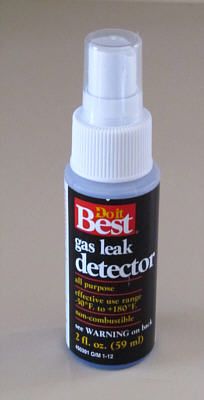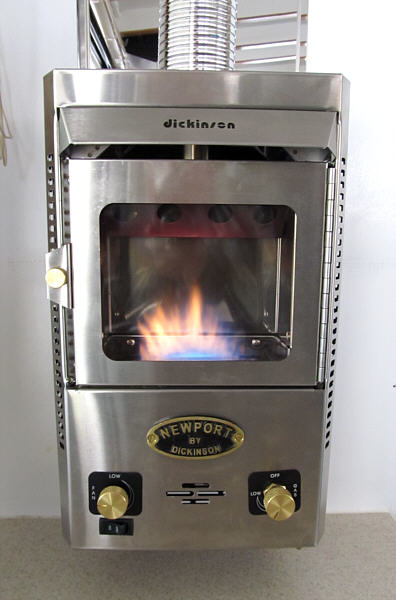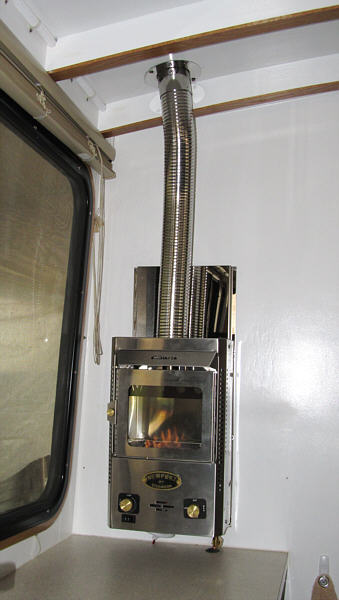I would like to start this entry with
a simple but important lesson I learned during the install described
below. When leak testing propane lines and fittings the installer is
always warned not to use a flame but rather a liquid leak detection
fluid that will bubble and expose the problem. I somewhat correctly
assumed it was to prevent the possibility of an explosion or flare up
if gas was detected. But what I discovered is it is not the only reason.
 Because I was confident at the time there was no
buildup of gas I decided to ignore the warning and us a flame to check.
Yes, I know what you are thinking but although not the best decision I
have ever made the no buildup assumption was correct. The open flame is quick, easy and clean and in this situation provided no
“surprises” but also found no leaks. But still there was a problem.
Because I was confident at the time there was no
buildup of gas I decided to ignore the warning and us a flame to check.
Yes, I know what you are thinking but although not the best decision I
have ever made the no buildup assumption was correct. The open flame is quick, easy and clean and in this situation provided no
“surprises” but also found no leaks. But still there was a problem.
As suggested my system has a propane
pressure gauge installed in the high pressure line between the tank and
regulator. This is not used to try to measure the remaining fuel but as a
safety device. With the gas appliance shut off the tank valve is opened
to allow the pressure to build in the lines to normal operating levels.
The tank valve is then closed. The gauge can now be monitored and a
sinking needle indicates a leak somewhere in the system.
And this was my problem. Although my
“flame test” had revealed no leaks the pressure gauge was indicating
otherwise. Admittedly the leak was very small and it took an hour for
the pressure to drop enough to be noticed but it would definitely drop.
Further testing narrowed the leak to the low pressure side which is between the regulator and the heater. I again tried the
flame test and could find nothing. I was perplexed.
One
of the reasons I went with the
highly discouraged flame method is I seemed to remembered reading
something years ago that some liquid soaps can be corrosive to copper
if they remain on the surface. I am not sure this is accurate but the
foggy memory pushed me away from mixing up my own bubbling brew. But
now it
was stumped. I had never noticed a specific product for doing the
bubble test but to my surprise a trip to my local “Do It Center”
yielded a small pump spray bottle of liquid (about $3) designed
specifically for the purpose. (Yea, I know - probably water and liquid
soap!)
I
sprayed it on the flare fittings but
to be honest I did not expect it to help. After all, if it was leaking
the flame should have indicated the escape of gas. At first I thought
my pessimism was valid as I noticed no bubbles being created. But I
decided to take a closer look and used a flashlight to help illuminate
the somewhat poor light conditions. And there it was. I had to look
very close – VERY close – but could some tiny bubbles growing along the
threads of the fitting. There was the leak! I then wiped off the liquid
and once again used the flame to check it – nothing. The flame in no
way revealed the problem. I tightened the fitting and rechecked and the
problem was still there. Further investigation revealed a crimped
fitting was cracked beneath the nut and had to be replaced.
Had this gone unaddressed eventually a total hose failure could
have resulted with possible disastrous results. Propane systems demand vigilant attention and maintenance.
So that was my lesson and it makes
sense when you think about it. With only ½ lb of pressure on the line
the leak was present but just too small to support a flame by
itself. I learned testing with a flame was not
only dangerous but also ineffective for small leaks. Another important fact to add to my mental "Do It Yourself"
data base.
***********************************************************************************************************

 As mentioned previously, I have a propane system
on SeaQuinn. Because the gas is heavier than air extreme caution is
needed in its installation, operation and maintenance. If a fault
occurs the gas can collect in a low point in the hull and an errant
spark could ignite it with catastrophe results. Being aware of the
possible consequences I am very diligent if not somewhat paranoid about
the system.
As mentioned previously, I have a propane system
on SeaQuinn. Because the gas is heavier than air extreme caution is
needed in its installation, operation and maintenance. If a fault
occurs the gas can collect in a low point in the hull and an errant
spark could ignite it with catastrophe results. Being aware of the
possible consequences I am very diligent if not somewhat paranoid about
the system.
In order to extend my cruising season
I decided to add a propane heater. During the construction I had
anticipated this addition and had installed the necessary plumbing in
the propane locker as well as had run the hose from the locker to the
intended location. This greatly simplified the procedure and drilling
the access hole for the gas line through the counter top was about all
that was needed.
I originally purchased a Sig Cozy
Cabin Heater for the install but came to the conclusion I could not get
the suggested clearances in the only location I had available to place
it. I liked that the unit was compact, had a small 1” chimney
and was reasonably priced. I didn’t like it required a window to be
cracked or another opening to the outside to draw fresh air for
combustion. Also, to me it appeared most all of the surfaces would
become very hot and a source of possible burns. In fact, many photos I
had seen of units in use show the stainless steel shell seriously discolored from
the heat causing the units to be somewhat unattractive.
I ultimately decided to resell the
brand new Sig unit on Ebay and purchase a Dickinson Newport P1200
heater. The heater includes a small fan to help circulate the hot air
and most all of the surfaces remain cool enough to prevent any injury.
It does not require an outside vent for combustion as the fresh air is
drawn down the outer layer of the chimney and the exhaust exits through
the center. In my estimation the unit is much more refine and better
built. Plus to my eye it is more attractive. But there is a downside.
To accommodate the two way flow of air the chimney is 3” in diameter.
And I find that LESS attractive. Then there is the cost which is over
double the Sig unit.
The heater arrived and was installed with little problem other than the gas leak mentioned above. I haven’t yet had the opportunity to use it while on the water but it appears it will work well. Once I have a little experience with it I will follow up with an addition to this page.
UPDATE 02/2013
We have found on a cloudy day the heater will raise the interior temperature about 15 degrees. In other words, if the outside is 50 degrees the heater will bring it up to about 65 degrees. I was honestly hoping for more but this seems to be about its maximum. I will say the cabin has NO insulation of any type and a lot of glass in the form of windows. I am sure this is a large part of the problem. But sunshine helps a lot. On a sunny day the combination of the heater and the sun will warm the cabin to much higher levels.